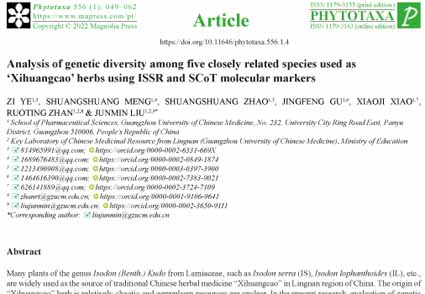Abstract
Many plants of the genus Isodon (Benth.) Kudo from Lamiaceae, such as Isodon serra (IS), Isodon lophanthoides (IL), etc., are widely used as the source of traditional Chinese herbal medicine “Xihuangcao” in Lingnan region of China. The origin of “Xihuangcao” herb is relatively chaotic and germplasm resources are unclear. In the present research, evaluation of genetic diversity and genetic variability in 358 accessions of ‘Xihuangcao’ herb from 33 populations were carried out based on ISSR and SCoT makers. Thirteen ISSR and 8 SCoT markers produced 491 and 272 fragments respectively, of which 99.80% (490) and 99.26% (270) were polymorphic, H=0.1719 I=0.1704 for ISSR and H=0.2057 I=0.3300 for SCoT revealed high genetic diversity. Both genetic differentiation analysis and AMOVA revealed higher variance among the populations than within populations. According to UPGMA and PCoA, the clustering patterns of populations were out of accordance with plant taxonomy or geographic distribution. This study showed that the germplasm resources of “Xihuangcao” had high genetic diversity, which could provide materials for excellent breed screening and core collections developing.
References
Bertrand, C.Y., Collard-David, J. & Mackill (2009) Start Codon Targeted (SCoT) Polymorphism: A Simple, Novel DNA Marker Technique for Generating Gene-Targeted Markers in Plants. Plant Molecular Biology Reporter 27 (1): 86–93. https://doi.org/10.1007/s11105-008-0060-5
Chen, J.N., Jiang DX, Zhao AG, Lai XP (2006) Microscopic Identification of Medicinal Material of Herba Rabdosiae Serrae. Journal of Guangzhou University of Traditional Chinese Medicine 1: 52–55.
Chen, L.J., Chen, Y.Q., Shi, S.H., Ye, C.X. & Lai, X.P. (1999) RAPD Analysis on Chinese Medicine Xihuangcao and Its Related Species. Acta Scientiarum Naturalium Universitatis Sunyatseni 38 (01).
Chen, L.J., Miao, Y. & Lai, X.P. (2000) Pollen Morphology of Chinese Herb ‘Xihuangcao’ and Its Related Species. Journal of Xiamen University ( Natural Science) (04): 547–551.
Chen, L.J., Qu, L.H., Shi, S.H., Li, Z.H. & Lai, X.P. (1998) Differentiation of Original Plants of Xihuangcao by Using Random Amplified Polymorphic DNA (RAPD) Markers. China Journal of Chinese Materia Medica 23 (06): 8–10.
Chen, W.F., Wong, L.L., Zhang, X., Zhou, F.X., Xia, F., Tang, L.P. & Li, X. (2019) New 4,5-seco-20(10?5)-abeo-Abietane Diterpenoids with Anti-Inflammatory Activity from Isodon lophanthoides var. graciliflorus (Benth.) H.Hara. Chemistry & Biodiversity 16 (6): e1900206.
Liu, F., Huang, H.B., Lou, B.Q. & Li, L.H. (2010) Morphological identification of four origin plants of Xihuangcao. Chin Med J Res Prac 24 (03): 30–31.
Deng, Q.H., Zhang, W.L., Wang, D.Q., Yao, X.H., Huang, Y.N., Ou, X.H. & Huang, L. (2012) Discussion on Two Original Plants Used as Chinese Herbal ‘Xihuangcao’ in Chinese Pharmacopoeia 2010 Edition. Chin Med J Res Prac 26 (04): 21–23.
Flora of China Editorial of Chinese Academy of Sciences (1977) The Flora of China. Vol. 66. Science Press, Beijing, pp. 416.
Guangdong Food and Drug Administration (2011) Standards of Traditional Chinese Medicines in Guangdong Province. Vol. 2. Guangdong Science and Technology Press, Guangdong, pp. 347–353.
Huang, D.L., Chen, X.K., Xu, Y.Q., Chen, Y. & Chen, Z.X. (2013) Analysis of different parts of Rabdosia serra ( Maxim.) Hara by FT-IR. Chinese Traditional Patent Medicine 27 (01): 64–68.
Huang, S.S. (2016) Research Progress of Traditional Chinese Medicine Xihuangcao. Pharmacy Today 26 (05): 365–368.
Huang, S.S., Hu, W.M., Zeng, S.H., Mo, X.L. & Wang, Y. (2019) Comparative transcriptome analysis and simple sequence repeat marker development for two closely related Isodon species used as ‘Xihuangcao’ herbs. Tropical Journal of Pharmaceutical Research 18 (1): 75–84. https://doi.org/10.4314/tjpr.v18i1.12
Igwe, D.O., Ihearahu, O.C., Osano, A.A., Acquaah, G. & Ude, G.N. (2022) Assessment of genetic diversity of Musa species accessions with variable genomes using ISSR and SCoT markers. Genetic Resources and Crop Evolution 69: 49–70. https://doi.org/10.1007/s10722-021-01202-8
Lin, C.Z., Liu, F.L. & Zhang, R.J. (2019) High-Performance Thin-Layer Chromatographic Fingerprints of Triterpenoids for Distinguishing Between Isodon lophanthoides and Isodon lophanthoides var. gerardianus. Journal of AOAC International 102 (03): 714–719. https://doi.org/10.5740/jaoacint.18-0305
Li, G.M., Li, Z.C., Xu, K.Y. & Wen, L. (2007) Analysis on Genetic Diversity of Germplasm Resources of Anticancer Plant Rabdosia rubescens (Labiatae). Journal of Tropical and Subtropical Botany 16 (2): 116–122.
Mahmodi, N., Sharifi-Sirchi, G.-R. & Cheghamirza, K. (2022) Evaluation of molecular and morphological diversity of caper (Capparis spinosa L.). Genetic Resources and Crop Evolution. https://doi.org/10.1007/s10722-021-01315-0
Perrino, E.V., Valerio, F., Jallali, S., Trani, A. & Mezzapesa, G.N. (2021) Ecological and Biological Properties of Satureja cuneifolia Ten. and Thymus spinulosus Ten.: Two Wild Officinal Species of Conservation Concern in Apulia (Italy). A Preliminary Survey. Plants 10 (9): 1952. https://doi.org/10.3390/plants10091952
Poczai, P., Varga, I., Laos, M., Cseh, A., Bell, N., Valkonen, J. & Hyvonen, J. (2013) Advances in plant gene-targeted and functional markers. Plant Methods 9 (6): Article number 6. [31 pp.] https://doi.org/10.1186/1746-4811-9-6
Suddee, S., Paton, A.J. & Parnell, J.A.N. (2004) A Taxonomic Revision of Tribe Ocimeae Dumort. (Lamiaceae) in Continental South East Asia I. Introduction, Hyptidinae & Hanceolinae. Kew Bulletin 59 (03): 337–378. https://doi.org/10.2307/4110949
Wong, L.L., Liang, Z.T., Chen, H.B. & Zhao, Z.Z. (2016) Rapid differentiation of Xihuangcao from the three Isodon species by UPLC-ESI-QTOF-MS/MS and chemometrics analysis. Chinese Medicine 11 (01): 2–6. https://doi.org/10.1186/s13020-016-0120-y
Wright, S. (1931) Evolution in mendelian population. Genetics 16: 97–159. https://doi.org/10.1093/genetics/16.2.97
Yan, W., Li, J., Zheng, D., Friedman, C. & Wang, H. (2019) Analysis of genetic population structure and diversity in Mallotus oblongifolius using ISSR and SRAP markers. Peer J 7: e7173. https://doi.org/10.7717/peerj.7173
Zhou, Y.Q., Zhou, C.N., Yao, H.L., Liu, Y.J. & Tu, R.T. (2008) Application of ISSR markers in detection of genetic variation among Chinese yam (Dioscorea opposita Thunb) cultivars. Life ence Journal 5 (4): 6–12.


